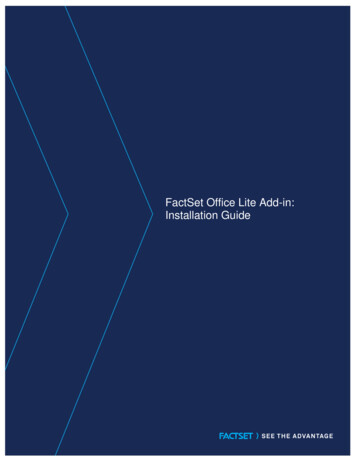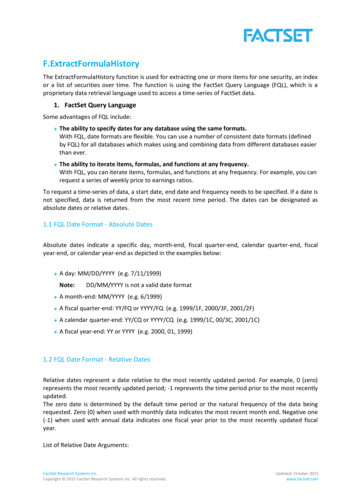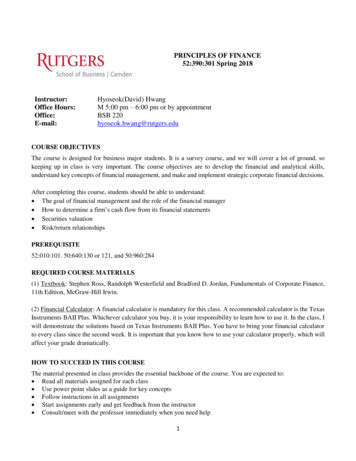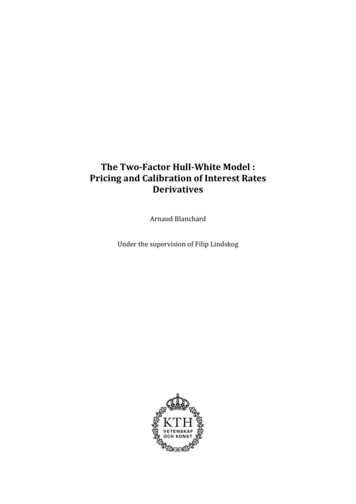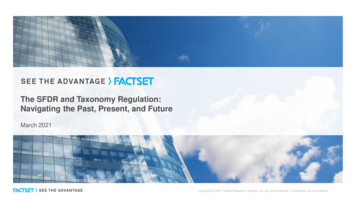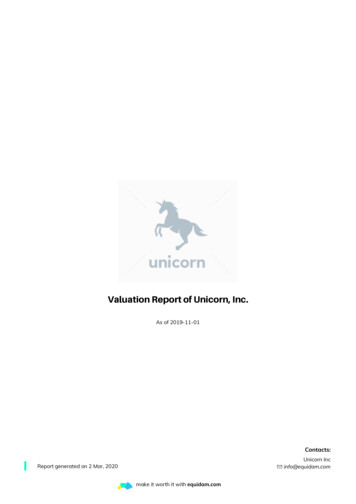
Transcription
White PaperInterest Rate Swap ValuationTom P. Davis, PhD
White PaperInterest Rate Swap ValuationContentsIntroduction .2History of the Projecting and Discounting Curves .3Valuation .6Valuation Example .7Value of a Swap Over Time.11Summary .11Appendix A .12Appendix B .12Appendix C .13References .13IntroductionAn interest rate swap is a legal contract entered into by two parties to exchange cash flows on an agreed upon set offuture dates. The interest rate swaps market constitutes the largest and most liquid part of the global derivatives market.At the end of June 2014, the total notional amount of outstanding contracts was 563 trillion, representing 81% of theover-the-counter global derivatives market, and the gross market value of interest rate derivatives totaled 13 trillion.1The focus of this paper is on plain vanilla swaps, which constitute the vast majority of the OTC swap market.Each stream of cash flows is referred to as a “leg.” A plain vanilla interest rate swap has two legs – a fixed leg and afloating leg. The fixed leg cash flows are set when the contract is initiated, whereas the floating leg cash flows aredetermined on “rate fixing dates,” which occur close to the beginning of the payment period and are specified as part ofthe contract terms and conditions.The current market value of an interest rate swap is determined by the prevailing interest rate environment on thevaluation date, represented by the set of current interest rate curves. There are two important curves for valuing interestrate swaps – the overnight curve and the floating rate index curve relevant to the jurisdiction, which for plain vanillaswaps is the Interbank Offered Rate (IBOR).In this paper, IBOR will refer to a generic interbank offered rate. When a specific IBOR is referenced, such as the USDLondon Interbank Offered Rate (LIBOR), the more specific name will be used (i.e., USD LIBOR). For instance, thisdistinction becomes important to differentiate between Euribor , which is the interbank offered rate for the euro set bybanks in the Eurozone, and EUR LIBOR, which is the interbank offered rate for the euro set by banks in London.1 Bank for International Settlements, “OTC Derivatives Statistics at End-June 2014”, 2014, https://www.bis.org/publ/otc hy1411.pdf.Copyright 2016 FactSet Research Systems Inc. All rights reserved.FactSet Research Systems Inc. www.factset.com2
The correct curves depend on the jurisdiction in which the swap is being valued, as shown in Table 1:Table 1: Curves by Jurisdiction2JurisdictionRelevant Overnight CurveOvernight Day Count3USDU.S. Federal Reserve (federal funds rate)ACT/360GBPSterling Overnight Index Average (SONIA)ACT/365JPYTokyo Overnight Average Rate (TONAR,also called MUTAN)ACT/365EUREuro Overnight Index Average (Eonia )ACT/360CHFSwiss Average Rate Overnight (SARON )ACT/360A crucial difference between the overnight rates and IBOR indices is that overnight rates are averages of uncollateralizedovernight lending rates that actually transact in the market, not averages of hypothetical funding rates that do nottransact. The market tends to show that the overnight rates are more representative of the lowest credit risk; therefore,the overnight rate is the closest proxy to the risk-free rate. Furthermore, since the overnight rate is representative of anactual market transaction, it is less prone to manipulation by the participants that determine the rate. LIBOR rates are setby a polling procedure at 11:00 a.m. GMT each day. USD LIBOR rates are determined by asking 18 of the memberbanks what rate they could receive to borrow uncollateralized funds in the interbank market. The calculation agentcollects the quotes and removes the top four and bottom four. The average of the remaining 10 quotes defines LIBORand is then published by market data providers.The overnight rate curve is constructed using a bootstrapping and interpolation process based on the liquidly tradedmarket instruments that reference the overnight rate, usually Overnight Index Swaps (OIS) instruments.The IBOR curve is constructed using a bootstrapping and interpolation process based on the prices of liquidly tradedcontracts that reference the IBOR rate. In order of maturity, these instruments are cash deposits up to around one year,followed by Eurodollar futures with maturities up to two years, and interest rate swaps with maturities from two years to30 years. FactSet obtains these market data quotes daily from Tullett Prebon.2 OpenGamma, 'Interest Rate Instruments and Market Conventions Guide', df.3 See 2006 ISDA Definitions. (New York, NY: International Swaps and Derivatives Association, Inc., 2006) for comprehensive descriptions of day countconventions.Copyright 2016 FactSet Research Systems Inc. All rights reserved.FactSet Research Systems Inc. www.factset.com3
History of the Projecting and Discounting CurvesPrior to 2007, both the projecting index curve and the discounting index curve could be calculated using a unique curve.An index rate was related to the discount factor curve by an arbitrage relationship. The index rate was determined to bethe unique simple rate of interest relating the zero coupon bonds between the accrual start date and the accrual end date(equivalently the rate start date and the rate maturity). To avoid arbitrage, the rate can be inferred from the discountcurve by setting up a portfolio that is initially costless.Equation 1 shows how to calculate the expected index rate determined by the current interest rate environment:Equation 1:𝐷(𝑡, 𝑇𝑖 ) 𝐷(𝑡, 𝑇𝑖 𝜏) 𝜏𝐿𝜏𝑖 (𝑡) 𝐼𝑛𝑑𝑒𝑥 𝑅𝑎𝑡𝑒𝐷(𝑡, 𝑇𝑖 𝜏)Where: 𝐷(𝑡, 𝑇𝑖 ) The discount factor, representing the price of a zero coupon bond at the time it is bought (𝑡) andthe time it matures (𝑇𝑖 ) 𝜏 The tenor of the index rate, usually three months or six months depending on the jurisdictionThis equation served as the definition of the index rate and is usually written in a different form, as shown in Equation 2:Equation 2:𝐼𝑛𝑑𝑒𝑥 𝑅𝑎𝑡𝑒 4 𝜏𝐿𝜏𝑖 (𝑡) 1𝐷(𝑡, 𝑇𝑖 )( 1)𝜏 𝐷(𝑡, 𝑇𝑖 𝜏)Where: 𝐷(𝑡, 𝑇𝑖 ) The discount factor, representing the price of a zero coupon bond at the time it is bought (𝑡)andthe time it matures (𝑇𝑖 ) 𝜏 The tenor of the index rate, usually three months or six months depending on the jurisdictionIn 2008, the world changed. The ability to determine the index rate from the discount curve in Equation 1 was no longervalid. In other words, the same curve could no longer be used to project future cash flows and to discount future cashflows as evidenced by the persistent non-zero basis spreads.In this post-crisis world, Equation 2 was modified by adding a spread, as shown in Equation 3:Copyright 2016 FactSet Research Systems Inc. All rights reserved.FactSet Research Systems Inc. www.factset.com4
Equation 3:𝐼𝑛𝑑𝑒𝑥 𝑅𝑎𝑡𝑒 𝐿𝜏𝑖 (𝑡) 1𝐷(𝑡, 𝑇𝑖 )( 1) 𝜅(𝑡)𝜏 𝐷(𝑡, 𝑇𝑖 𝜏)Where: 𝜅 𝜏 (𝑡) A tenor (𝜏) dependent piecewise constant spread 𝐷𝐷(𝑡, 𝑇𝑖 ) The discount factor, representing the price of a zero coupon bond at the time it is bought (𝑡)andthe time it matures (𝑇𝑖 ) 𝜏 The tenor of the index rate, usually three months or six months depending on the jurisdiction4 The tau superscript on 𝐿𝜏𝑖 (𝑡) is usually known from context and can be omitted.A spread can arise in two ways, both having the same financial fundamental origin. First, as a liquidity premium reflectedin the IBOR index rates and second as a credit spread. All things being equal, an investor would rather receive paymentsmore frequently;5 the reason is credit worthiness of the institutions quoting IBOR. Prior to 2007, the IBOR index rates didnot account for the possibility of major banks defaulting; therefore, the rates did not reflect a credit spread. The events in2007-2008 showed that it was unreasonable to assuming top-tier banks could not default. The spreads all demonstratethe correct behavior as inferred by the credit argument that lower tenors will trade at spreads lower than higher tenorsdue to the decreased time over which the lending took place. This is carried out in both the USD and EUR markets asshown in Figure 1 and Figure 2.Figure 1: USD LIBOR Spreads versus 6M5 LIBOR rates set the magnitude of the swap floating rate cash flows; therefore, the intuition is that the market demanding a premium will serve toincrease the rate. This is the opposite behavior of the yield of a bond, where market demand will increase the price of the bond and therefore decreaseits yield.Copyright 2016 FactSet Research Systems Inc. All rights reserved.FactSet Research Systems Inc. www.factset.com5
Figure 2: Euribor Spreads versus 6MTo construct the projection curve, the OIS instruments are used to determine the base curve and then the LIBOR-basedinstruments are applied. In some economies the situation is more complex than described here, but the complicationsare only technical in nature and there is no barrier to constructing the relevant curves.Since discounting and projection can’t be determined using a single curve, the question naturally arises as to whichcurve should be used to discount. Two different answers emerged: Theoretical – The LIBOR was previously considered to be the risk-free rate. The body of quantitative finance tellsus we must discount at the risk-free rate when pricing derivative securities. Whereas LIBOR involved some creditworthiness of the banks that quote LIBOR, the overnight rate is the actual rate traded in the market foruncollateralized lending between banks for one day. Because of this, the overnight rate is now recognized as thebest proxy for the risk-free rate. Funding – The time value of money is closely connected to how a firm obtains the money to meet futureobligations.When a swap is perfectly collateralized in cash, the two schools of thought agree that the OIS is the correct curve to usefor discounting. Therefore, we will use Equation 3 for the remainder of the paper.ValuationThe terminology of a swap is determined by which party pays the fixed leg. A swap is called a “payer” swap if you are theparty paying the fixed leg. A swap is called a “receiver” swap if you are the party paying the floating leg and thereforereceiving the fixed leg.The value of an interest rate swap is the difference between the paying leg and the receiving leg. Fundamentally, thelegs are no different from other financial instruments; each coupon payment is the present value of the product of aprincipal, an accrual fraction, and a coupon rate. For interest rate swaps, the principal is referred to as a notionalprincipal amount (NPA) due to the fact that this amount is never exchanged.6 If the principal were paid, it would have noCopyright 2016 FactSet Research Systems Inc. All rights reserved.FactSet Research Systems Inc. www.factset.com6
impact on the valuation of an interest rate swap, as both legs would pay this amount at maturity and thereby exactlyoffset the value from the other leg.The current market value of a receiver swap is given in Equation 4:Equation 4:𝑁𝑀𝑅𝑒𝑐𝑒𝑖𝑣𝑒𝑟 𝑆𝑤𝑎𝑝 𝐶𝑢𝑟𝑟𝑒𝑛𝑡 𝑀𝑎𝑟𝑘𝑒𝑡 𝑉𝑎𝑙𝑢𝑒 𝑉(𝑡, 𝜏, 𝑐) 𝐷(𝑡, 𝑇𝑖 ) · 𝑁 · 𝜏𝑖 · 𝑐 𝐷(𝑡, 𝑇𝑗 ) · 𝑁 · 𝜏𝑗 · (𝐿𝑗𝜏 (𝑡) 𝜅 𝜏 )𝑖 1𝑗 1Where: 𝐷(𝑡, 𝑇𝑖 ) The discount factor, representing the price of a zero coupon bond at the time it is bought (𝑡)and the time it matures (𝑇𝑖 ) 𝑁 Number of payments on the fixed leg 𝑇𝑖 Paying leg payment frequency 𝑐 Coupon 𝐷(𝑡, 𝑇𝑗 ) The discount factors determined by the current interest rate environment 𝜏𝑗 Receiving leg payment frequency 𝐿𝑗𝜏 (𝑡) The expected index rates determined by the current interest rate environment 𝜅 𝜏 Spread above LIBOR implied by the overnight curveThe set of dates will generally be different for the fixed leg and the floating leg. This means the paying leg and receivingleg have different payment frequencies. Typically, the floating leg is more frequent, every other floating leg payment datelines up with the corresponding fixed leg payment date, and the maximum values of 𝜏𝑖 and 𝜏𝑗 are equal (𝑇𝑁 𝑇𝑀 ).For instance, USD swaps are semi-annual fixed leg payments swapped for quarterly floating leg payments. The actualfrequency depends on the currency of the swap. The major conventions for the major currencies are shown in Table 2:Table 2: Swap Conventions for Major Jurisdictions7JurisdictionFixed Leg FrequencyFixed Leg Day CountFloating Leg FrequencyFloating Leg Day CountUSD6M30/3603MACT/360EUR ( 1Y)1Y30/3606MACT/360GBP ( 1Y)6MACT/3656MACT/365JPY6MACT/3656MACT/360CHF ( 1Y)1MY30/3606MACT/360At trade execution, both legs will price close to par. The swaps will be issued at the “par swap rate”8, which is the uniquevalue of the coupon in Equation 4 that leads to a swap having zero value (𝑉 0). The result can be thought of as a typeof average value of the prevailing interest rates, as shown in Equation 5:6 Since this principal is never exchanged, it is only “notionally” the principal, meaning “in name only.” Although in practice, “notional” and “principal” areusually used interchangeably.7 OpenGamma, 'Interest Rate Instruments and Market Conventions Guide', 2013, est-rateinstruments-and-market-conventions.pdf.8 The par swap rate can be found by setting Equation 4 to zero (with no spread (𝜅) present) and solving for the value of 𝑐.Copyright 2016 FactSet Research Systems Inc. All rights reserved.FactSet Research Systems Inc. www.factset.com7
Equation 5:𝐴𝑛 𝐴𝑣𝑒𝑟𝑎𝑔𝑒 𝑜𝑓 𝑡ℎ𝑒 𝑃𝑟𝑒𝑣𝑎𝑖𝑙𝑖𝑛𝑔 𝐼𝑛𝑡𝑒𝑟𝑒𝑠𝑡 𝑅𝑎𝑡𝑒 𝑠(𝑡, 𝑇) 𝑀Σ𝑗 1𝐷(𝑡, 𝑇𝑗 ) · 𝜏𝑗 · 𝐿𝑗𝜏 (𝑡)𝑀Σ𝑖 1𝐷(𝑡, 𝑇𝑖 ) · 𝜏𝑖Where: (𝑡, 𝑇𝑗 ) The discount factors determined by the current interest rate environment 𝜏𝑗 Receiving leg payment frequency 𝐿𝑗𝜏 (𝑡) The expected index rates determined by the current interest rate environment 𝐷(𝑡, 𝑇𝑖 ) The discount factor, representing the price of a zero coupon bond at the time it is bought (𝑡) andthe time it matures (𝑇𝑖 ) 𝜏𝑖 Paying leg payment frequencySteps to value the floating leg of a swap:1.Determine the rates from the projection curve (with careful treatment of date conventions)2.Add spread3.Calculate the coupon time fractions4.Calculate Discount factors (usually involves an interpolation9)5.Multiply all togetherSteps to value the fixed leg of a swap:1.Calculate coupon time periods2.Calculate discount factors (usually involves an interpolation10)3.Multiply by the fixed coupon rateThe value of the swap is the value of the leg you pay subtracted from the value of the leg you receive. This results in the“dirty price” of the swap. To calculate the “clean price” of the swap, subtract the accrued interest from the dirty price ofeach leg, and the clean price of the swap is the difference of the clean prices of the legs.Accrued InterestThe accrued interest represents the fraction of the upcoming cash flow that is owed to the current swap counterparty ifone of those counterparties was to change during the lifetime of the contract. Accrued interest is calculated the sameway for swaps as it is for bonds, as both fixed and floating cash flows are already known during the cash flow period.Together with the magnitude of the fixed rate cash flows, this quantity can be calculated by both counterparties as theonly part of the swap calculation that both counterparties can agree on to arbitrary precision. The accrued interest iscalculated as shown in Equation 6:9 See Appendix B10 See Appendix B.Copyright 2016 FactSet Research Systems Inc. All rights reserved.FactSet Research Systems Inc. www.factset.com8
Equation 6:𝐴𝑐𝑐𝑟𝑢𝑒𝑑 𝐼𝑛𝑡𝑒𝑟𝑒𝑠𝑡 𝛼(𝑡, 𝑇𝑛 1 )𝐶𝐹𝑛𝜏𝑛Where: 𝛼(𝑡, 𝑇𝑛 1 ) The day count fraction between the accrual end date of the last coupon period, where 𝑡 is the daycount of the current cash flow period and 𝑇𝑛 1 is the last coupon period's accrual end date 𝜏𝑛 The day count of the current cash flow period 𝐶𝐹𝑛 The cash flow associated with the current coupon periodSince these two quantities are always calculated in the same day count convention, the denominators for most accrualconventions will cancel and the accrued interest simplifies to Equation 7:Equation 7:𝐴𝑐𝑐𝑟𝑢𝑒𝑑 𝐼𝑛𝑡𝑒𝑟𝑒𝑠𝑡 (𝑆𝑖𝑚𝑝𝑙𝑖𝑓𝑖𝑒𝑑) 𝑑𝐶𝐹𝐷 𝑛Where: 𝑑 The number of days since the start of the current accrual period 𝐷 The number of days in the current accrual period 𝐶𝐹𝑛 The cash flow associated with the current coupon periodTherefore, the fraction becomes the ratio of the number of days that have passed since the last accrual end date and thenumber of days in the current cash flow period (as calculated in the numerator of the day count function).Valuation ExampleSuppose a bank sells (pays the fixed rate) a collateralized three-year 0.95% swap with a principal of 1,000,000 on 4Jun-2014. Since the swap is denominated in euros, the fixed leg is annual 30/360 and the floating leg is semi-annualACT/360, as shown in Table 2. In the following sections, we calculate the value of the swap on the settlement date (thedate on which the valuation takes place) of 23-Jun-2014.Fixed LegThe fixed leg is the easier of the two legs to value since the coupon does not need to be estimated. The pricing istherefore similar to pricing a fixed rate bond; simply discount the known cash flows. The difference is that a bond iscalculated using a flat yield, whereas a swap is always valued “off a curve,” meaning the discounting is done with theprevailing zero coupon bond. Another crucial difference is that most bonds have level coupons, where the coupons arethe same for all cash flow periods, regardless of whether they contain the same number of days. Fixed legs of swaps donot have level coupons; the magnitude of the coupon depends on the accrual convention and business day adjustmentrules stated in the contract:Copyright 2016 FactSet Research Systems Inc. All rights reserved.FactSet Research Systems Inc. www.factset.com9
Table 3: Fixed Leg Payment ScheduleDateCoupon RateTotal Coupon PaymentDiscount FactorPV Of Payment4-Jun-20150.95% 9,500.000.999582613 9,496.004-Jun-20160.95% 9,500.000.998771416 9,488.004-Jun-20170.95% 1,009,500.000.996254447 1,005,719.00The sum of the present value (PV) of the payments gives the dirty price of the fixed leg.The accrued interest for the fixed leg is calculated using a 30/360 day count method. For this swap, the accrual fractionis particularly simple – one year is always 1.0 in the 30/360 day count method. Therefore, we only need to count thenumber of days since the last coupon payment up to, but not including, the settlement date. In this example, there are 19days since the last coupon payment (4-Jun- 2014) and the settlement date (23-Jun-2014). Therefore, the accruedinterest is equal to 19/360 multiplied by the total coupon payment, resulting in 501.00 of accrued interest as of thesettlement date.Floating LegValuing the floating leg is similar to valuing the fixed leg. However, to value a floating leg the coupon must be determinedfrom the prevailing yield curve:DateCoupon RateTotal Coupon PaymentDiscount FactorPV Of Payment4-Dec-20140.386% 1,962.170.999773010 1,962.004-Jun-20150.445% 2,249.720.999582762 2,249.004-Dec-20150.445% 2,262.080.999270810 2,260.0044-Jun-20160.232% 1,179.330.998771721 1,178.004-Dec-20160.232% 1,179.330.997834606 1,177.004-Jun-20170.641% 1,003,240.610.996254908 999,483.00The sum of the PV of the payments gives the dirty value of the floating leg.The accrued interest is also calculated in a similar fashion as the fixed leg; however, the floating leg day count method isACT/360. The numerator is the number of days since the beginning of the current coupon period and the settlementdate. In this example, there are 19 days in the period, the same as the fixed leg in this case. The denominator is theactual number of days in the current coupon period. The current coupon period begins on 4-Jun-2014 and ends on 4Dec-2014, which gives 182 days in the period. Therefore, the accrued interest is 19/182 of the total coupon, resulting in 204.00 of accrued interested as of the settlement date.Copyright 2016 FactSet Research Systems Inc. All rights reserved.FactSet Research Systems Inc. www.factset.com10
Net Value of a SwapThe net value is calculated by taking the difference of the present value of the two legs of the swap. Since the bank soldthis swap, they are the fixed leg payer. From the bank’s perspective, the value is the difference of the floating leg (asset)and the fixed leg (liability). This net value is the dirty price of the swap, since it is based on total cash flows. From thecorporate’s perspective, who bought the swap, they are the fixed leg receiver. The net value from the corporate’s point ofview is the difference of the fixed leg (asset) and the floating leg (liability). There is a portion of the current cash flow thatwould need to be paid to the seller of the swap, if it were sold. As stated above, the clean price is the difference betweenthe net value and the accrued interest. The clean price of the swap is calculated by first calculating the clean price ofeach leg and subsequently performing the same difference.Note that the present value of the notional exactly cancels when the final difference is taken. Due to this fact, the notionalis not exchanged at inception or maturity of an interest rate swap (hence the terminology “notional principal amount”).Value of a Swap Over TimeImmediately after the trade execution the swap will no longer have zero value, even if the interest rate environmentremains unchanged due to interest accruing and coupons being paid. For example, half of the coupon will have accruedone quarter into a swap contract that pays semi-annually. Recall that this amount of money is due to the holder of theswap upon transfer of this contract to a third party. Therefore, even though the future cash flows net to zero for a parswap, it no longer has a zero market value.If the interest rate environment changes (i.e., if there are changes in the market quotes that determine the yield curve,such as the cash rates, futures, and swap rates traded in the market) then the floating rate coupons used to determinethe par swap will not be the value of the floating rate coupons paid throughout the lifetime of the swap. Swaps are said tobe “in-the-money” for the owner of the side of the swap where the interest rate movements are favorable and the contractbecomes an asset. For example, when interest rates decrease the fixed rate receiver (the floating rate payer) is in-themoney since their forecasted payments are greater than their actual payments. Conversely, for the fixed rate payer (thefloating rate receiver) the swap is “out-of-the-money.” This can be determined by calculating the par swap rate for theremaining tenor of the swap compared to the fixed rate in the contract:Table 5: Moneyness Definitions for SwapsCurrent Par Swap Fixed RateCurrent Par Swap Fixed RateFixed Rate PayerIn the moneyOut of the moneyFixed Rate ReceiverOut of the moneyIn the moneyIntuitively, if the current par swap rate is higher than the par swap rate at swap initiation, the party paying the contractedfixed rate is better off, whereas if the current par swap rate is lower, the party receiving the contracted fixed rate is betteroff.SummaryThis paper summarizes the important aspects of swap valuation, from the calculation of the cash flows to thedetermination of market value from swap initiation to maturity. While there are many similarities to pricing bonds, thesubtle differences can lead to mispricing, incorrect attribution, and counterparty disputes. Furthermore, this paperhighlights the importance of incorporating non-zero LIBOR spreads that appeared in the LIBOR quotes after the financialcrisis of 2008.Copyright 2016 FactSet Research Systems Inc. All rights reserved.FactSet Research Systems Inc. www.factset.com11
Appendix AGetting the Dates RightWhen performing the valuation of an interest rate swap versus a counterparty, it is crucial to agree on the rate dates.Rates have four important dates: The date on which the expectation is taken The date on which the rate is fixed for the cash flow The accrual start date The accrual end dateFor coupons, the date on which the cash flow is paid is also included. For interest rate swaps, this is usually very close tothe accrual end date.Figure 3: Schematic Timeline of Important DatesAppendix BInterpolation with Natural Cubic SplineThe assumptions in the natural cubic spline are that the functional form of the interpolating function is cubic withcoefficients determined by three constraints: continuity, smoothness, and continuity of the second derivative. Thisproduces an underdetermined problem, which is solved by the further constraint that the second derivative at the firstand last known point is zero. Other splines exist, such as the “clamped spline,” where the first derivatives are specified atthe boundary as well as the “financial spline,” where the first derivative is set to zero at the boundary (this naturally lendsitself to a flat rate extrapolation).Copyright 2016 FactSet Research Systems Inc. All rights reserved.FactSet Research Systems Inc. www.factset.com12
Appendix CDefinitionsTable 6: Common Terms and DefinitionsTermDefinitionBusiness CenterThe holiday calendar that is relevant for aspects of the contract. For instance, the payment businesscenter indicates which days are allowable for determining when payments occur, whereas the ratefixing business center will determine which days are allowable for determining when the rate fixingcan occur. The latter usually includes London because the LIBOR rates are fixed there and theycannot be fixed on a London bank holiday.Business DayAdjustmentIndicates how the relevant date (i.e., payment date, rate fixing date) is adjusted if the calculated datefalls on a bank holiday in the relevant business center. The standard is “modified following,” whichmeans that the relevant date will be the next good business day after the calculated date, unless thatadjustment lands in the next calendar month, in which case the preceding good business day ischosen. Other possibilities are following, previous, and modified previous.For instance, if the swap pays on the 29th of each month, and 29-Apr-2011 was determined to be aLondon bank holiday due to the royal wedding, LIBOR cannot fix on that date. The next goodbusiness day in London was Monday, 3-May-2011. Note this fell into the next month, so any contractspecifying “modified following” would use 28-Apr-2011 as the next roll date.Calculation AgentSpecifically who determines the floating rate as well as where and when the observation for thefloating rate index will take place. This section also specifies how to determine the rate during apricing disruption event. The term “determining party” is similar; however, there could be a slightlydifferent legal interpretation between the two.Day Count BasisThe method of calculating the length of time between two dates. Typical values are ACT/360, whereyou take the “actual” number of days between two dates and divide by 360. Note this will give a daycount fraction greater than 1.0 for one year. Other methods include ACT/365 and 30/360. The daycount basis is also known as day count fraction.11Fixed RateThe coupon rate that is not pegged to a financial observable index.LegOne of the streams of cash flows. A typical vanilla interest rate swap has a fixed leg and a floatingleg. Other legs exist, such as “structured” legs, where the cash flow is determined by a complexformula of financial observables, such as interest rate indices and foreign exchange rates.Rate Fixing DatesThe date on which a rate for the upcoming coupon period is set. The contract will specify how this isset by specifying a calculation agent and a series of prescriptions/mitigations to follow if thecalculation agent is unavailable. Also known as roll date.Roll DateAnother name for rate fixing date. The term roll date is favored in the industry.References2006 ISDA Definitions. New York, NY: International Swaps and Derivatives Association, Inc., 2006.Bank for International Settlements. “OTC Derivatives Statistics at End-June 2014”, 2014.https://www.bis.org/publ/otc hy1411.pdf.OpenGamma. “Interest Rate Instruments and Market Conventions Guide”, research/Interest-Rate-Instruments
The interest rate swaps market constitutes the largest and most liquid part of the global derivatives market. At the end of June 2014, the total notional amount of outstanding contracts was 563 trillion, representing 81% of the over-the-counter global derivatives market, and the gross market value of interest rate derivatives totaled 13 .
